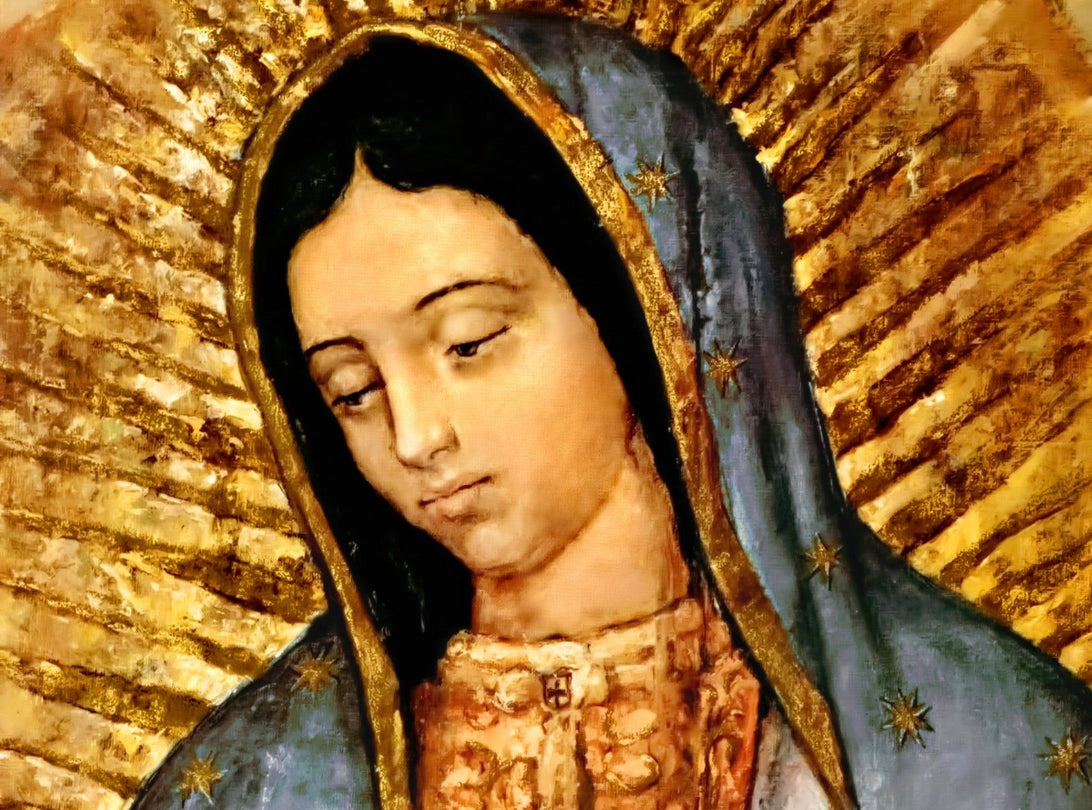Article: The Remarkable Story of Our Lady of Guadalupe and the Tilma

The Remarkable Story of Our Lady of Guadalupe and the Tilma
Housed in the Cathedral atop Tepeyac Hill in Mexico, centuries later, Juan Diego's tilma (cloak) bearing the Blessed Mother's image, remains one of the most fascinating and inexplicable relics of the Catholic Church.
The story of the tilma unfolds in 1531, when the Blessed Mother appeared four times to Saint Juan Diego on a hill outside present-day Mexico. Juan Diego was a poor humble Aztec Indian who had recently converted to the Catholic faith. During the first apparition, Our Lady asked Juan to go to the bishop and direct him to build a church in her honor where she said “I will show and offer all of my love, my compassion, my help and my protection to my people.” Juan Diego summoned his courage and did as she asked. The bishop was understandably skeptical and asked for a sign that this message was really from Our Lady.
On December 12th, during Juan’s second encounter with Our Lady, he explained the bishop’s request for a sign. In response, the Blessed Mother directed Juan Diego to an area where the most beautiful Castilian roses were growing and told him to gather them in his tilma. The presence of blooming roses was peculiar, since it was winter and the barren ground typically sustained only cacti and thistles. Juan Diego wrapped the roses in his tilma and returned to the bishop. When he unfolded his cloak, the bishop was overcome by the beauty of the roses and the miraculous image of the Virgin Mary found on the tilma. He fell to his knees and pledged to fulfill her request to build the church. “Within seven years of this apparition, in which Our Lady manifested herself to the native peoples of Mexico as a sign of her maternal care, nine million accepted the Catholic faith. Remarkably, this amounts to an average of over 3000 people a day, every day for the next seven years.”
Centuries later, Juan Diego's tilma bearing the Blessed Mother's image, remains one of the most inexplicable relics of the Catholic Church, captivating believers and skeptics alike with its enduring nature. For decades, NASA and other selected scientists, scrutinized the tilma, arriving at a singular conclusion: its miraculous nature remains unexplained. Here are some amazing facts about the tilma of Our Lady of Guadalupe:
- Material and Durability: The tilma was found to be made of agave fibers known as ayate, which are known to disintegrate within a few decades due to their organic material. However, the tilma has defied this expectation by remaining perfectly intact for over 500 years without any special preservation methods!
-
Inexplicable Weightlessness: Despite its large size and the material used, the tilma weighs significantly less than expected. The fabric itself should weigh much more due to its composition, yet it remains remarkably lightweight.
- Indestructible: Two different events threatened the image: acid was accidentally spilled on it in 1784 and a bomb was set off underneath it on November 14, 1921, yet the tilma remained unscathed.
- Symbolism and Meaning: The specific clothing and symbolism in which Our Lady appeared on the tilma held immense significance for the Aztec Indians. She was dressed in royal clothes to signify she was very important, perhaps a queen. She also had the symbol of the cross at her neck which was the same symbol the Spaniards placed on their ships and in the churches. The ribbon around her waist would be seen as a symbol of pregnancy and was associated with the sacredness of life. Also on her beautiful dress were many flowers, but there was one four-petal flower that was very significant. To the Aztecs, the four petal flower was the symbol for the true God, the God above all gods. This flower was located over the womb— a revelation that would convey to the Aztecs that she was the mother of God.
- The Stars on her mantle: Further captivating symbolism lies in the stars on the Virgin's mantle, believed to correspond to the constellations during the time of year of the reported apparitions.
-
Lack of Known Pigments: The image of Our Lady of Guadalupe was clearly not created by human hands. Microscopic analysis of the image by NASA revealed that there were no visible brush strokes or pigments that could explain the image's creation. The coloration seemed to be stamped or embedded within the fibers of the tilma. The original image of the Virgin herself does not appear to have been painted by an artist. There is no sketch underneath it, no brush strokes, and no corrections. It appears to have been produced in a single step.
-
Retention of Vibrant Colors: The tilma's image has also remained remarkably vibrant and not faded, despite exposure to elements like moisture, candle smoke, and environmental conditions.
- Microscopic Details in the Eyes: High-resolution studies have revealed what appear to be human the eyes in the sense that they look like a photo of a human being, with the depth and reflection of a human eye.
-
Miraculous Properties: Countless accounts of miraculous occurrences and healings have been attributed to the tilma, fostering a deep devotion among believers.
-
Popularity and Pilgrimages: The Basilica of Our Lady of Guadalupe in Mexico City, where the tilma is housed, is one of the most visited Catholic pilgrimage sites globally.
- Papal Recognition: Popes throughout history have acknowledged and venerated the tilma, recognizing its importance in the Catholic faith.
Juan Diego, the humble man to whom she appeared, was declared a saint in 2002. So far has her message reached, that she is now considered the patroness of all the Americas. Our Lady of Guadalupe is also known as the Patroness of the Unborn.
We have designed several pendants and Sacred Blocks in honor of Our Lady of Guadalupe! Click here to see our collection and may you be graced by God through her intercession!


